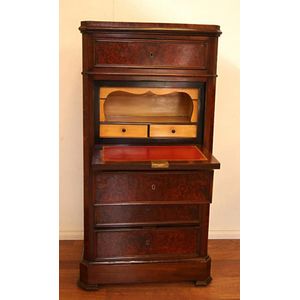Elizabethan Oak Court Cupboard, Circa 1880
You must be a subscriber, and be logged in to view price and dealer details.
Subscribe Now to view actual auction price for this item
When you subscribe, you have the option of setting the currency in which to display prices to $Au, $US, $NZ or Stg.
- Circa - A Latin term meaning 'about', often used in the antique trade to give an approximate date for the piece, usually considered to be five years on either side of the circa year. Thus, circa 1900 means the piece was made about 1900, probably between 1895 and 1905. The expression is sometimes abbreviated to c.1900.
- Elizabethan - Strictly speaking, furniture usually in oak, made in the reign of Elizabetht I, from 1558 to 1603. The style incororates elaborate and ostentatious carving of classicial figures and themes and bulbous baluster legs, with an Italian Renaissance influence. When a piece is described as "Elizabethan style", it mimics the attributes of the Elizabethan period, but was made at a later date.
- Oak - Native to Europe and England, oak has been used for joinery, furniture and building since the beginning of the medieval civilisation. It is a pale yellow in colour when freshly cut and darkens with age to a mid brown colour.
Oak as a furniture timber was superceded by walnut in the 17th century, and in the 18th century by mahogany,
Semi-fossilised bog oak is black in colour, and is found in peat bogs where the trees have fallen and been preserved from decay by the bog. It is used for jewellery and small carved trinkets.
Pollard oak is taken from an oak that has been regularly pollarded, that is the upper branches have been removed at the top of the trunk, result that new branches would appear, and over time the top would become ball-like. . When harvested and sawn, the timber displays a continuous surface of knotty circles. The timber was scarce and expensive and was used in more expensive pieces of furniture in the Regency and Victorian periods.
This item has been included into following indexes:
Visually similar items

Antique 18th century French oak two piece buffet, with four doors, approx 167 cm high, 134 cm wide

A French amboyna fall front escritoire. 131 cm high, 69 cm wide, 37 cm deep

An early 18th century oak pined plant top mule chest. 81 cm high, 143 cm wide, 54 cm deep.

Art Deco oak fall front desk, c. 1930, the fall front opening to reveal a fitted interior with writing surface, above a pair of doors with chrome plated pulls, on carved ball feet, height 106 cm, width 76 cm, depth 48 cm. Provenance: Private Collection, Sy
